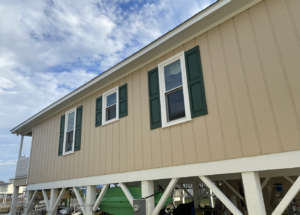
Types of Windows
- Double-Hung Windows: have two vertically sliding sashes, which can be opened from the top and bottom. Some benefits of this type of window include ventilation control, easy to clean, and suitable for small areas.
- Casement Windows: hinged on one side and swing outward; normally operated using a crank handle. Some benefits of this type of window include maximum airflow when opened, improved insulation when closed, and unobstructed views.
- Bay Windows: stick outward from the exterior wall of a building and normally consist of a larger central window with two small flanking windows at an angle. Some benefits of this type of window are enhancing interior spaces creating nooks or space for plants or decorations and improved natural light.
- Bow Windows: project outward from the wall but consist of multiple curved or arched window panes that create a continuous curve. Some benefits of this type of window are a sense of openness and elegance added to a space.
- Picture Windows: large, fixed windows with a single pane of glass that is not openable. Some benefits of this type of window are unobstructed views and energy efficiency since they do not open and are airtight.
- Awning Windows: hinged at the top and open outward from the bottom normally using a crank handle. Some benefits of this type of window are that they can be left open in light rain and can be placed higher on walls to allow hot air to escape while still maintaining privacy.
How Can These Windows Be Energy-Efficient?
Energy-efficient windows are designed to minimize heat transfer and keep the indoor temperature at a stable level, which reduces the need for constant heating or cooling, lowering energy consumption.
Energy-efficient windows often feature low-emissivity (Low-E) coatings, which reflect infrared light, allowing visible light to pass through while blocking the transfer of heat. Many of these windows have multiple panes of glass with insulating gas between them that creates a barrier reducing heat transfer. Materials like vinyl, fiberglass, or wood can help prevent heat conduction since they have insulation properties. Having tight seals and weather strips around the windows prevents air leaks, which maintains indoor temperatures. These are all important factors to consider when installing new windows as they can significantly reduce the cost of energy bills in the long run.
